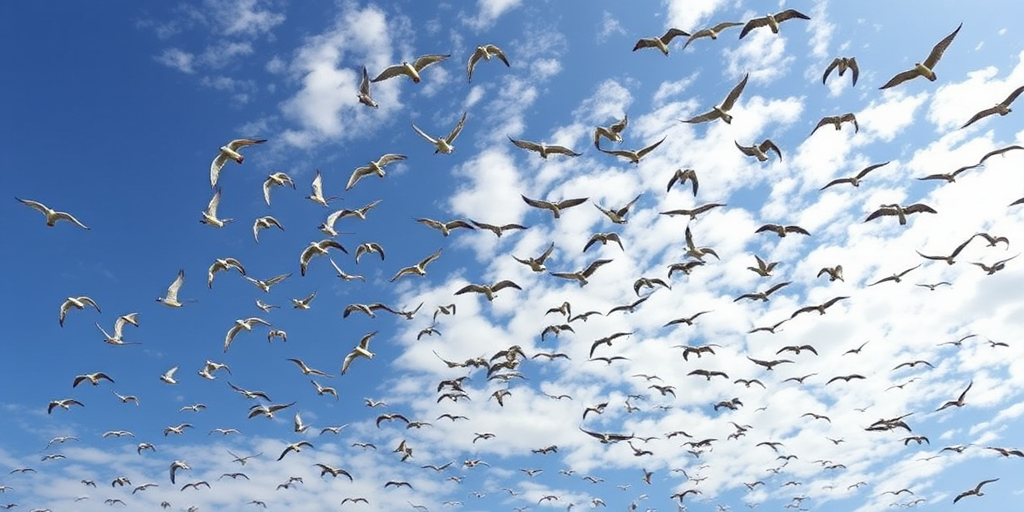Have you ever wondered how high birds soar during migration? Radar studies reveal that many species cruise between 1.5 and 3 kilometers above ground, defying simplistic assumptions about their flight. This discussion combines precise scientific data with compelling field observations to examine the atmospheric and behavioral factors driving these impressive altitudes. By enhancing understanding of migratory dynamics, the analysis offers actionable insights for advancing conservation strategies and promoting safer bird habitats.
Birds and Migration Altitudes: Scientific Factors Shaping Flight Heights
Environmental conditions and physiological constraints jointly shape the heights at which birds migrate. Atmospheric phenomena including solar radiation and weather dynamics interact with the intrinsic capabilities of avian species to determine optimal flight altitudes. Research indicates that birds frequently adjust their ascents to benefit from environmental forces, minimizing energy expenditure while mitigating the risks of overheating during daylight hours. Miniaturized multisensor data loggers have provided precise measurements, revealing that diurnal patterns influence flight height as birds ascend to cooler layers later in the day. These observations underscore the significance of atmospheric conditions in their aerial routes.
Recent studies emphasize the influence of external factors which collectively contribute to migration altitude decisions. Birds benefit from a combination of physical forces during their ascent, and a clear understanding of these factors facilitates advanced atmospheric ascent analysis. The following numbered list summarizes key elements that directly affect migratory elevation:
- Tailwinds
- Thermal updrafts
- Topographical influences
- Temperature gradients
Each item represents a critical environmental component that birds exploit to conserve energy and optimize their flight paths. By capitalizing on beneficial wind conditions and thermal currents, birds can navigate complex terrain and avoid adverse temperature layers.
Miniaturized sensor data coupled with atmospheric modelling further quantify the impact of these factors on flight performance. The table below outlines specific environmental aspects, their impacts on migratory flights, and concrete examples observed in field studies.
| Factor | Impact | Example |
|---|---|---|
| Tailwinds | Enhance lift and reduce energy expenditure | Assisted flights during migratory corridors |
| Thermal updrafts | Provide natural lift, facilitating altitude gain | Daytime convective currents used by soaring species |
| Topographical influences | Alter wind flow and create localized lift zones | Ridges and valleys affecting flight paths |
Integrating atmospheric data with species-specific flight mechanics advances the understanding of migration strategies and refines predictive models for avian behavior.
Birds and Migration Altitudes: Case Studies and Species Insights

Case studies illustrate how species-specific adaptations enable birds to overcome the challenges of long-distance migration. Eastern curlews, for instance, manage high altitude flights that facilitate their 7,000-mile journeys by capitalizing on transient thermal currents and wind patterns. Red knots, facing morphological changes that include shorter bills and legs, must navigate both altitude adjustments and shifts in prey accessibility during their flight from Mauritania to Siberia. Such precision in flight behavior reflects an intricate balance between aerodynamic efficiency and ecological demands.
A close examination of these cases reveals notable altitude-related traits across species. Researchers have observed that Hudsonian godwits maintain high traversal altitudes during their 9,000-mile migration, requiring minimal refueling stops. These examples highlight the role of altitude selection in optimizing energy reserves necessary for sustaining lengthy flights. The following bullet-point list summarizes key species and their notable altitude characteristics:
- Eastern curlews
- Red knots
- Hudsonian godwits
- Additional shorebirds
Comparative analysis of these species demonstrates the importance of tailored flight strategies. The table below offers insights into altitude dynamics and corresponding notes on migratory performance:
| Species | Altitude/Notes |
|---|---|
| Eastern curlews | Utilize high thermal currents to cover over 7,000 miles |
| Red knots | Experience physical adaptations influencing altitude tactics |
| Hudsonian godwits | Maintain elevated flight paths during 9,000-mile journeys |
These examples emphasize that species-specific morphological and behavioral traits directly inform the ability to achieve and sustain varied flight altitudes during migration.
Final Words
In the action, the article examined migratory flight altitudes, atmospheric influences, and modern tracking technologies.
It highlighted scientific observations, case studies, and regional conservation efforts that illuminate altitude ranges from 1.5 km to 3 km.
The discussion offered practical insights and encouraged proactive habitat protection while emphasizing species-specific migratory patterns.
The insights affirm Birds and Migration Altitudes: How High Do They Fly, fostering optimism and a deepened appreciation for the marvels of avian migration.
FAQ
How high do birds typically fly during migration?
A: Migratory birds typically fly at altitudes between 1.5 to 3 kilometers above ground level during their seasonal journeys. Radar data shows most species maintain these heights for optimal wind conditions.
What is the highest recorded altitude for a bird?
A: The Rüppell’s griffon vulture holds the record for highest flying bird, recorded at 11,278 meters (37,000 feet) when it collided with an aircraft over West Africa.
What factors determine birds’ flight heights?
A: Birds select flight heights based on wind patterns, air temperature, thermal updrafts, and topographical features. These factors help them conserve energy and maintain efficient travel speeds.
How do birds navigate during high-altitude migration?
A: Birds use a combination of magnetic fields, celestial cues, landmarks, and inherited genetic knowledge to navigate during migration. Their sensory systems process multiple environmental inputs simultaneously.
What speeds do birds achieve during migration?
A: Migratory birds average speeds between 20-60 kilometers per hour. With favorable tailwinds, some species can reach speeds of 90-100 kilometers per hour during sustained flight.
How far can birds fly without stopping?
A: Some birds, like the Bar-tailed Godwit, can fly up to 11,000 kilometers without stopping. They store energy in fat reserves and use efficient flight techniques to cover these distances.
Do birds fly above clouds during migration?
A: Birds typically fly below cloud level, staying under 3 kilometers altitude. However, some species occasionally ascend above clouds to access favorable wind conditions or avoid adverse weather.


